
Monte Circeo or Cape Circeo is a mountain promontory that marks the southwestern limit of the former Pontine Marshes, located on the southwest coast of Italy near San Felice Circeo. At the northern end of the Gulf of Gaeta, it is about 5 kilometres (3.1 mi) long by 1.5 kilometres (0.93 mi) wide at the base, running from east to west and surrounded by the sea on all sides except the north. The land to the northeast is the former ancient Pontine Marshes. Most of the ancient swamp has been reclaimed for agriculture and urban areas.

The Province of Latina is an area of local government at the level of province in the Republic of Italy. It is one of five provinces that form the region of Lazio. The provincial capital is the city of Latina. It is bordered by the provinces of Frosinone to the north-east and by the Metropolitan City of Rome Capital to the north-west.

The Pontine Marshes is an approximately quadrangular area of former marshland in the Lazio Region of central Italy, extending along the coast southeast of Rome about 45 km (28 mi) from just east of Anzio to Terracina, varying in distance inland between the Tyrrhenian Sea and the Volscian Mountains from 15 to 25 km. The northwestern border runs approximately from the mouth of the river Astura along the river and from its upper reaches to Cori in the Monti Lepini.

The Tuscan Archipelago is a chain of islands between the Ligurian Sea and Tyrrhenian Sea, west of Tuscany, Italy.
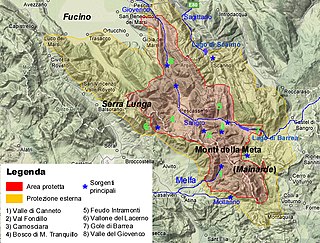
Abruzzo, Lazio and Molise National Park is an Italian national park established in 1923. The majority of the park is located in the Abruzzo region, with smaller parts in Lazio and Molise. It is sometimes called by its former name Abruzzo National Park. The park headquarters are in Pescasseroli in the Province of L'Aquila. The park's area is 496.80 km2 (191.82 sq mi).
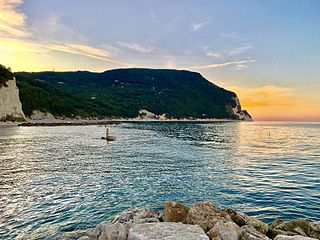
Monte Conero or Mount Conero, also known as Monte d'Ancona, is a promontory in Italy, situated directly south of the port of Ancona on the Adriatic Sea.

The Monti Aurunci is a mountain range of southern Lazio, in central Italy. It is part of the Antiappennini, a group running from the Apennines chain to the Tyrrhenian Sea, where it forms the promontory of Gaeta. It is bounded to the north-west by the Ausoni Mountains, to the north by the Liri river, to the east by the Ausente, to the south-east by the Garigliano and to the south by the Tyrrhenian sea. The line between the Aurunci and the Ausoni has not been clearly established but the Aurunci are considered by convention to be east of a line through Fondi, Lenola, Pico, S. Giovanni and Incarico. Altitudes vary from hills to the 1,533 m of Monte Petrella. Main peaks include the Redentore (1,252 m) and Monte Sant'Angelo (1,402 m). They include a regional park, the Parco Naturale dei Monti Aurunci, created in 1997.

The Parco Nazionale delle Foreste Casentinesi, Monte Falterona, Campigna is a national park in Italy. Created in 1993, it covers an area of about 368 square kilometres (142 sq mi), on the two sides of the Apennine watershed between Romagna and Tuscany, and is divided between the provinces of Forlì Cesena, Arezzo and Florence.

Algatocín is a town and municipality in the province of Málaga, part of the autonomous community of Andalusia in southern Spain. The municipality is situated approximately 143 kilometres (89 mi) from Málaga and 30 kilometres (19 mi) from Ronda. It is located in the west of the province in the Valle del Genal, being one of the townsⁿ that make up the comarca of the Serrania de Ronda. It is situated at an altitude of 725 metres (2,379 ft). The town has a population of approximately 900 residents, over a surface area of 20 square kilometres (7.7 sq mi), for a population density of 47 inhabitants per square kilometre (120/sq mi).
Pollino National Park is an Italian national park in the southern peninsula, in the provinces of Cosenza, Matera and Potenza. Its named from the homonymous mountain massif Pollino. The park is home of the oldest European tree, a Heldreich's pine estimated 1,230 years old and the symbol of the park is the rare Bosnian pine tree. Since November 2015, with the inclusion in the global list of geoparks by UNESCO, the Pollino Park is considered a World Heritage Site. Encompassing a total of 88,650 ha in the Lucanian side and 103,915 in the Calabrian one is the largest park in the country covering 1,925.65 square kilometers and among the 50 largest in the world. The common beech is the park's most prevalent tree and the park is also home to a variety of important medicinal herbs.

Maiella National Park is a national park located in the provinces of Chieti, Pescara and L'Aquila, in the region of Abruzzo, Italy.
The Giardino Botanico Ponziano is a private botanical garden located on Villa Madonna collina Belvedere, Ponza in the Pontine Islands, Province of Latina, Lazio, Italy.

The Mediterranean woodlands and forests is an ecoregion in the coastal plains, hills, and mountains bordering the Mediterranean Sea and Atlantic Ocean in North Africa. It has a Mediterranean climate, and is in the Mediterranean forests, woodlands, and scrub biome.
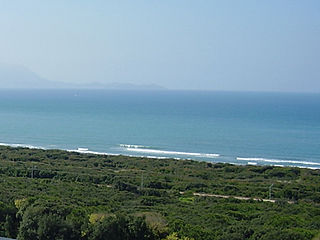
The Silva Gallinaria is a rich thicket characterized by evergreen trees and shrubs typical of the Macchia Mediterranea, which grows naturally on a sandy and devoid of water. The most common tree that reigns unchallenged is Quercus ilex. This kind of jungle resumed the general characteristics of the Mediterranean Evergreen Forest but is distinguished for being contextualized in the Campania territory, specifically inside the area around Cuma - Licola - Liternum, and the historical baggage that inherits the early settlers of this coast: the Greeks, who founded the city of Cuma, which today form an acropolis.
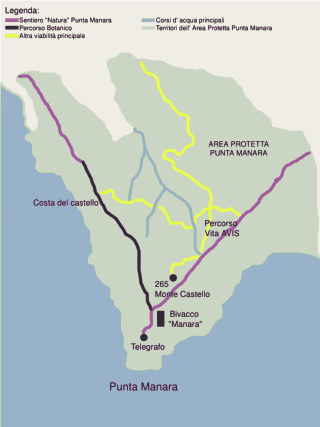
Punta Manara is the end of a promontory in the Gulf of Tigullio between the Ligurian towns of Sestri Levante and Riva Trigoso in the Province of Genoa, Italy. It has been subject to environmental protection since 1977.

The Iberian sclerophyllous and semi-deciduous forests is a Mediterranean forests, woodlands, and scrub ecoregion in southwestern Europe. It occupies the interior valleys and plateaus of the Iberian Peninsula. The ecoregion lies mostly in Spain, and includes some portions of eastern Portugal.

The Northeastern Spain and Southern France Mediterranean forests is a Mediterranean forests, woodlands, and scrub ecoregion in southwestern Europe. It occupies the Mediterranean coastal region of northeastern Spain, Southern France, the Balearic Islands and a small part of Italy.
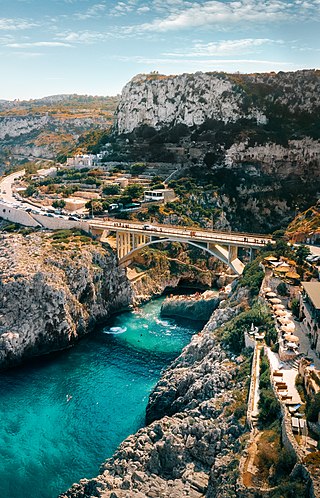
Ciolo is a narrow coastal inlet and a site of historical and environmental interest, which is located in Apulia, Italy. The location is also known as a geological site and for the presence of numerous sea caves, the largest one being the Grotta del Ciolo. Since October 2006 the Ciolo's area has become part of the Regional Park "Costa Otranto - Santa Maria di Leuca e Bosco di Tricase", created by the Apulia region to protect the eastern coast of Salento, specifically the architectural assets as well as important animal and plant species.

The Path of 100 Towers is a multi-day trekking route that begins and ends in Cagliari (Sardinia). The path is named after the 105 historical coastal towers along the route.

Mount Cucco is a mountain located in Umbria, along the Umbrian-Marche Apennines, in the area of Gubbio, included in the territory of the municipalities of Costacciaro, Scheggia e Pascelupo, Fossato di Vico and Sigillo. Since 1995 it has become a protected area under the name of Monte Cucco Park.


























